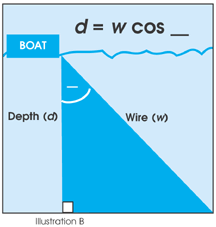THE DOWNRIGGER
The system has all been set
up, the boat is at a constant velocity, and we are fishing. Let's take
a look at the different forces acting on our system, starting with the
downrigger. The actual downrigger itself is above water and only
experiences the tension from the wire connected to the lead weight.
This gives good reason to focus more on the lead ball which is
considered part of the downrigger assembly. Because this part of
our system is traveling through a fluid, there will be a force due to
drag.
Remember: The only components that will be considered to have drag is the lead ball and the lure. In reality, drag is acting on every component under the water.
The downrigger lead ball is usually 4.5 - 5.5 kg (10 - 12 lbs.) and can be modeled with the images below. There is no spin on the ball due to reaction forces at the wire and ball connection counteracting any moments induced by the friction of the water moving over the ball's surface. Of course, the drag is acting in the opposite direction of the velocity, and the force of gravity acts in the downward direction. One force not shown below is the tension of the wire connecting the lead weight to the downrigger above.

Remember: The only components that will be considered to have drag is the lead ball and the lure. In reality, drag is acting on every component under the water.
The downrigger lead ball is usually 4.5 - 5.5 kg (10 - 12 lbs.) and can be modeled with the images below. There is no spin on the ball due to reaction forces at the wire and ball connection counteracting any moments induced by the friction of the water moving over the ball's surface. Of course, the drag is acting in the opposite direction of the velocity, and the force of gravity acts in the downward direction. One force not shown below is the tension of the wire connecting the lead weight to the downrigger above.

When this system is in
equilibrium, the
tension in
the
The
force
of
gravity
acting on the lead ball can easily be
wire acts at an angle to the level coordinate system. modeled by Newton's second law: F = ma. In doing so,
The tension is also acting in the upward direction. we can estimate the force to be around 45 Newtons.
wire acts at an angle to the level coordinate system. modeled by Newton's second law: F = ma. In doing so,
The tension is also acting in the upward direction. we can estimate the force to be around 45 Newtons.
This tension force has an "x"
and "y" components.
The "x" component results in forward motion while
the "y" component counteracts gravitational force.


The "x" component results in forward motion while
the "y" component counteracts gravitational force.


The force applied to
the lead ball due to drag is portrayed by: F = Kv^2
Where K is a drag constant to be determined experimentally, and v is velocity.
K is also directly proportional to the area of the lead weight, experimentally derived
drag coefficient, and density of the liquid (in our case, salt water). In the photo below, one
can see the actual disturbances made by an object traveling through a liquid. In our scenario,
this is exactly what's happening.

Just now we've examined how physics acts on one component of our system. To summarize, the net force
acting on the downrigger lead ball is zero because the velocity is constant (no acceleration). Because of drag
the lead ball is theoretically suspended in a liquid at an angle behind the boat. Now let's analyze some other components...
BACK HOME NEXT
Where K is a drag constant to be determined experimentally, and v is velocity.
K is also directly proportional to the area of the lead weight, experimentally derived
drag coefficient, and density of the liquid (in our case, salt water). In the photo below, one
can see the actual disturbances made by an object traveling through a liquid. In our scenario,
this is exactly what's happening.

Just now we've examined how physics acts on one component of our system. To summarize, the net force
acting on the downrigger lead ball is zero because the velocity is constant (no acceleration). Because of drag
the lead ball is theoretically suspended in a liquid at an angle behind the boat. Now let's analyze some other components...
BACK HOME NEXT